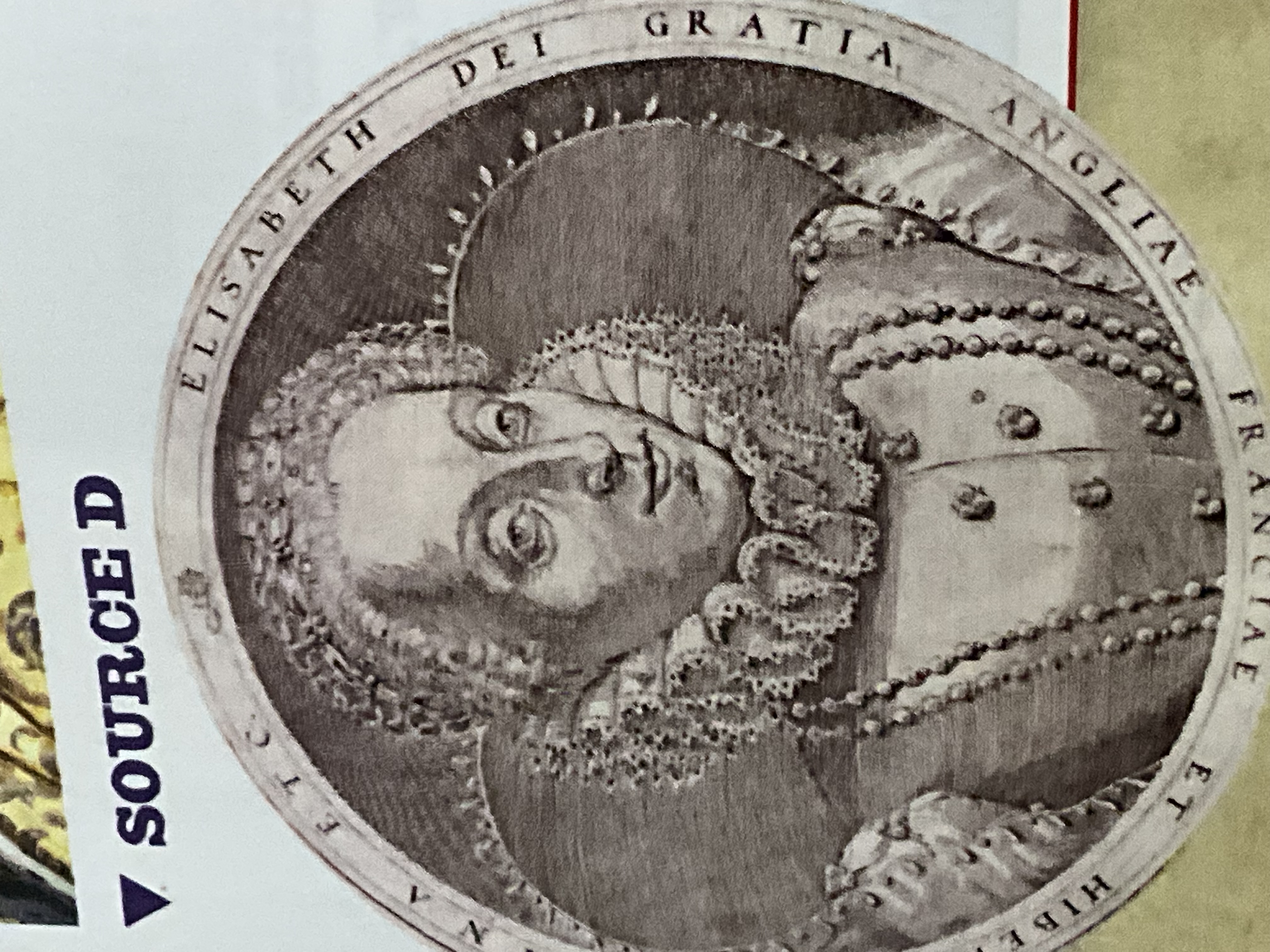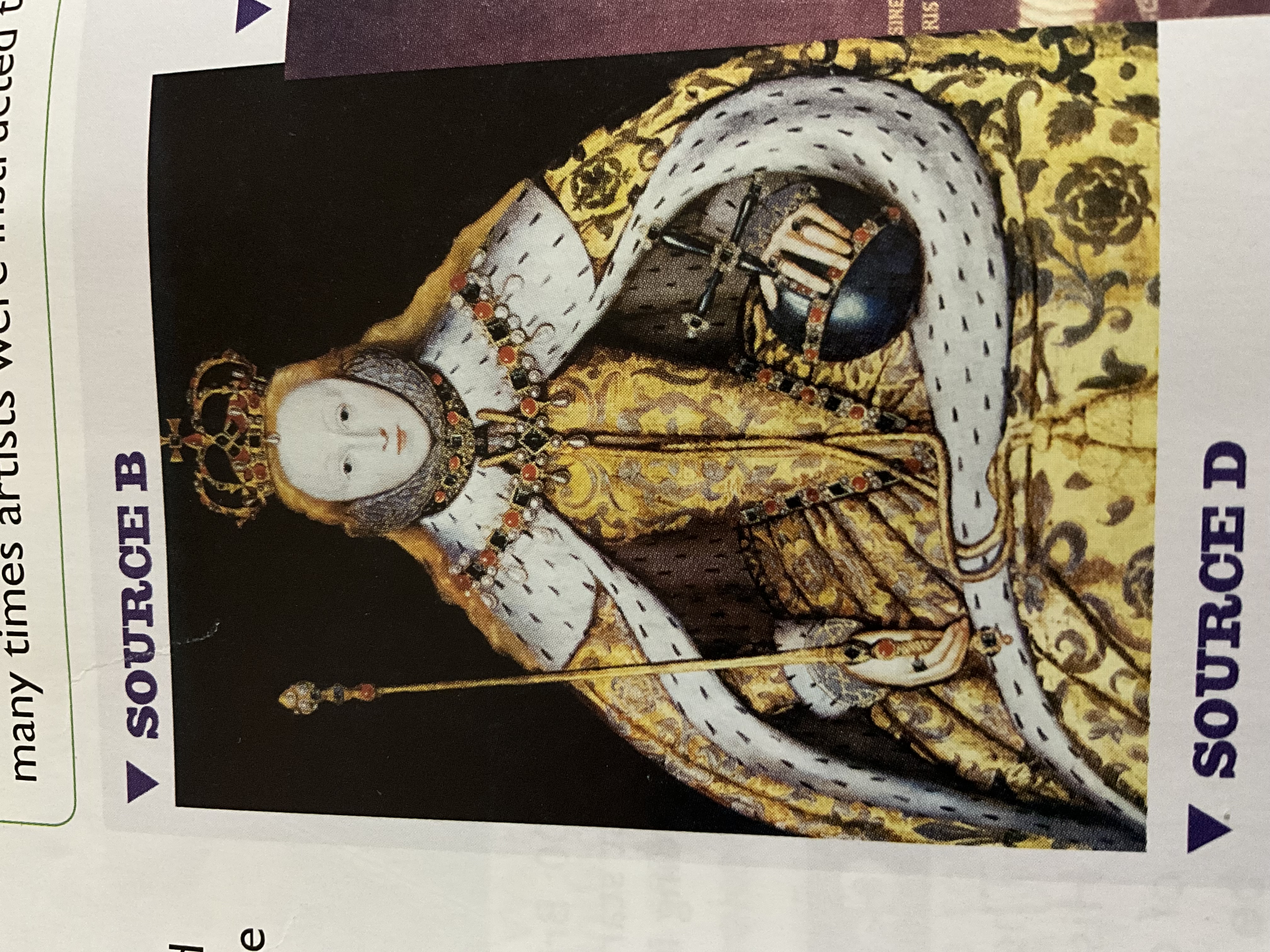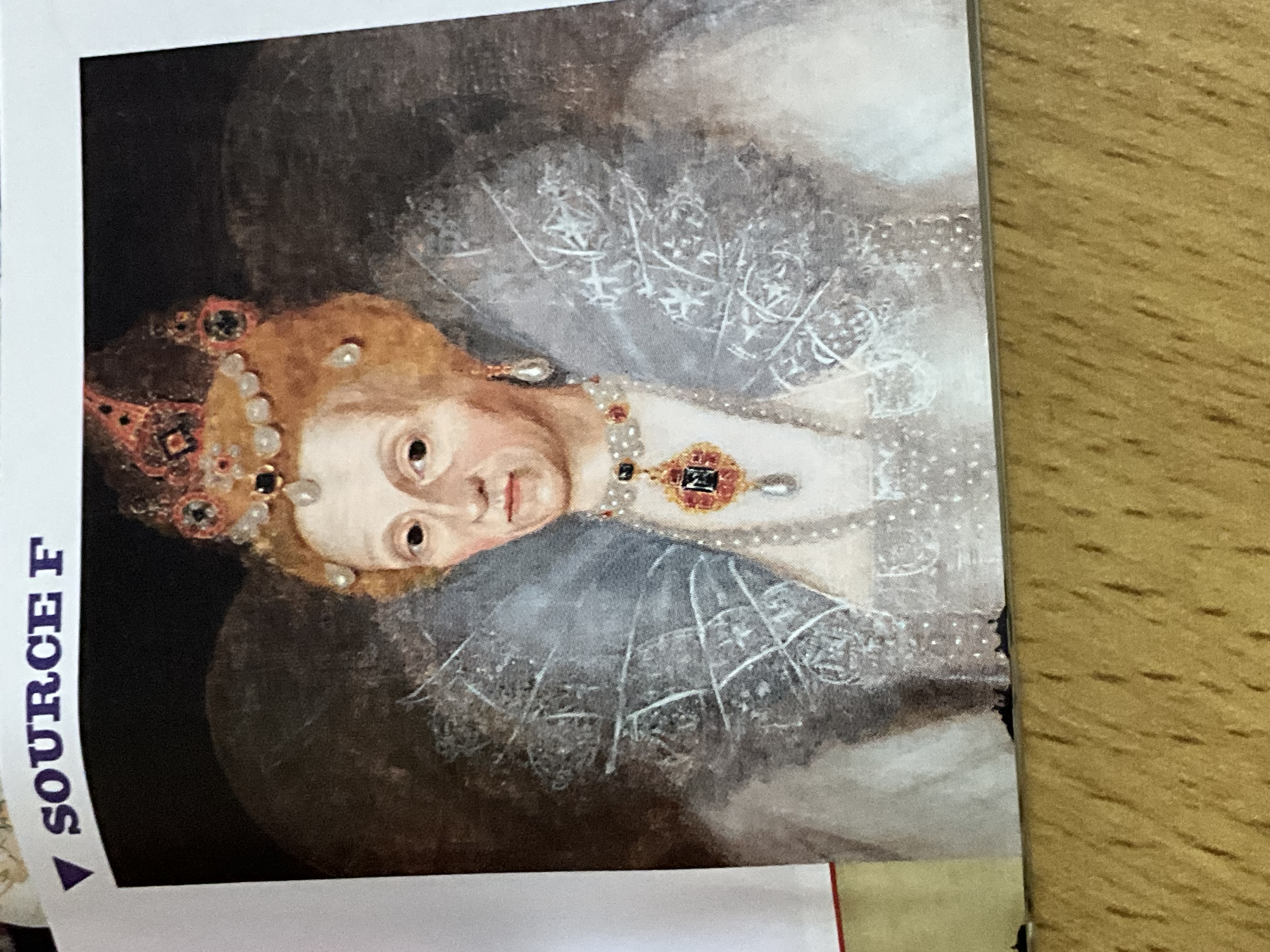Elizabeth I
1/40
Earn XP
Description and Tags
Name | Mastery | Learn | Test | Matching | Spaced |
|---|
No study sessions yet.
41 Terms
Young Elizabeth
She was born in 1553 September 7, her mother was Anne Boleyn, Henry IV’s second wife. When she was two years old her mother was executed. After the execution in 1536, she was declared illegitimate. and she was sent to live with her half-sister Mary. The girls had three houses: Hatfield, Eltham and Hudson house. When they travelled between each house they would fight over who would walk at the front of the procession. She didn’t seem to have an early life: a dead mother, tough father, a half sister and lots of stepmothers. In 1537 her half-brother Edward was born. Queen Elizabeth was very clever
She enjoyed learning
She had her own personal tutors the main ones were Roger Ascham and William Grindal. It was very famous at the time for young women to be highly educated. Elizabeth loved writing poems, learning new languages and translating foreign books.
She got attention because she was clever
King Henry was disappointed when Elizabeth was born but soon grew to love spending time with his clever daughter. When Henry visited Elizabeth, Mary was probably jealous. She was often kept away in a separate room while her father and Elizabeth talked, swapped gifts and sang together
She was lonely
She didn’t have any close friends. But reading books and learning new skills meant that she could talk about these things with people. People weren’t going to voice their real opinions about the country to the kings daughter, but they might be honest about their views on books, music and horses.
There were no activities to do
There was no tv, internet or even radios during this time. books, music and horse riding provided entertainment for her - and she seemed to be very good at many of the things she tried.
Elizabeth becoming queen
She was 13 in 1547 when her father died and her younger half-brother, Edward, became king when he was nine years old. Although she was quite close to Edward people still thought that she might be plotting against him during his short reign, as he died in 1553 when he was 15. However nothing could ever be proved against her. When Mary became queen in 1553, Elizabeth was suspected for plotting against the monarch- and again nothing could be proved. To be safe, Mary kept Elizabeth like a prisoner at various country houses. Five years later in 1558 Mary I died and Elizabeth bed came queen at 25 years old.
Line of succession
Henry VIII
Reign 1509-1547
1491-1547
Edward VI
Reign 1547-1553
1537-1553
Lady Jane Grey
Reign 1553 (9 days)
1537-1554
Mary I
Reign 1553-1558
1516-1558
Elizabeth I
reign 1558-1603
1533-1603
The religious settlement
She was a Protestant and she decided to return the country to protestant faith. Elizabeth was deeply religious, but wanted to avoid some of the more extreme events that had happened during the reign of her protestant half-brother Edward and her Mary. She hoped she would please most people and keep the country peaceful. Her ideas were known as the religious settlement. It is also known as her middle way. It was a course of action that avoided being totally catholic or totally protestant
The Middle way
Elizabeth made herself Governor (not the head) of the Church of England in order to please the Catholics. This meant that Catholics could still think of the Pope as the head of the church.
Priests were allowed to marry to please the protestant and a revised prayer book replaced the one from Edwards reign that was so hated by the Catholics
Catholics believed that bishops should have an important role in controlling the church. Elizabeth kept the bishops- but they were under her control. Church services and the Bible were in English which pleased Protestants.
The catholic service from Marys reign was changed to please protestants. Strict Catholics, who didn’t want to attend the new services had to pay fine for staying home (they were known as récusants)
Did the middle way work
Even though it pleased many people, extremists on both sides were left deeply unhappy by Elizabeths ideas. Very strict Protestants, known as Puritans did not want to compromise with Catholics, instead they wanted to remove all trace of the catholic faith in England. Strict Catholics believed that Protestants were a danger to religion and ‘damning the whole country to hell’. The Pope Pius V called Elizabeth a ‘pretend queen’ and excommunicated her. He also ordered the people of England not to obey her. This made it very difficult for Elizabeth to trust Catholics, as any one of them could be plotting her death. As a result, she decided to make life harder for catholics
Puritans
A strict protestant who believed in simple church services and lifestyles: they protested against the practices of the Catholic Church.
Catholic Clampdown
Sir Francis Walsingham, Elizabeths chief spy used secret agents to keep a close eye on important Catholics. In the 1580s new laws were passed that meant that Catholics priests could now be tried and executed. In 1581, the fine récusants had to pay was heavily increased to force them to leave the country, but instead meant ran out of money and were thrown in prison. Despite the threat of execution, many Catholic priests continued to hold their services in secret. To avoid capture and punishment dome priests were hidden in priest holes. Elizabeths long reign of 44 years meant that there was no catholic comeback and the protestant faith was firmly established.
Mary in France and Scotland
So she had been queen of Scotland from the age of six years old, after her father James V of Scotland died in 1542. She was too young to rule so her mother and other important Scottish nobles ruled in her place. She was brought up as a Catholic and married several times - firstly to a French King - Francis II- in 1558 who died young, then to an English Lord- Henry Stuart, Lord Darnley- in 1565 who was strangled to death and blown up, lastly in 1657- Earl Bothwell- who was suspected of being in the murder of her second husband.
Mary in England
Many Scots were suspicious of her connection to Lord Darnley, her second husbands death, and some rebelled against her. She was forced to give up the throne and her son James VI was made King of Scotland. In 1568, she ran away to England, perhaps looking for pity from Queen Elizabeth. In England she caused multiple problems for Elizabeth. First, she was catholic, and made it no secret that she thought she could be the Queen of England if Elizabeth died. Some English Catholics agreed with her. Elizabeth kept Mary a prisoner until she could decide what to do with her. She was imprisoned for 19 years in various houses and castles, and the two women never actually met. Eventually Elizabeth was forced to take action against Mary when she discovered the plot to kill her
The Babing’ton Plot
In 1586, a young rich Catholic called Anthony Babington came up with a secret plan to kill Elizabeth. He would organise six men to kill her, rescue Mary from her prison and make her the new queen of England. However Babington needed to know of Mary liked the idea. He needed to contact with her in prison, so he did this using letters.
Secret letters
Babington managed to get Mary’s servants to hide secret letters in Beer barrels that were taken to her room. The letters were written in code. Mary wrote back saying she agreed to the plan. However Marys servants worked for Englands chief spy Sir Francis Walsingham, who took the letters to queen Elizabeth. Once the code was broken the message was clear Mary was supporting a plan to kill the queen
Killing her cousin
Despite all the evidence against Mary, she didn’t want to execute her cousin. Eventually in Feb 1587, her secretary William Davidson slipped the death warrant in among some papers she had to sign. Elizabeth pretended she didn’t really know what she was signing, signed it, changed her mind then tried to stop the education, But she was too late Mary, Queen of. Scots had already been executed.
Spain
The richest, and most powerful country in the world. It had a huge army and Spanish ships were bringing a fortune in gold back to Spain from newly discovered lands. But in 1558, Spain’s King Phillip II decided to focus all his country’s great power and wealth on invasion of England. Every shipyard in Spain began building what many described ad the greatest navy- or Armanda- ever created. The massive fleet of 130 huge warships heading for one place- England
Why was Phillip angry with England
On 20 April 1587, Phillip received news that the famous English explorer of the time Sir Francis Drake had just sailed into Cadiz harbor in southern Spain and set fire to 30 of Spains royal warships,
For many years English sailors had been stealing Gold and silver from Spanish ships
Phillip who was a catholic found out that Mary Queen of Scots another catholic had been executed by the Queen of England Elizabeth I. He believed that people who had killed a Catholic queen should be punished. He started to build ships that could carry soldiers to invade England - it was these ships that drake had destroyed.
At this time, the Spanish Netherlands (Belgium and Luxembourg) were controlled by Spain but many people did not approve of this and rebelled against the Spanish control helped by English soldiers
Spain attack
By 1588 Phillips forces had recovered from Drakes attack on Cadiz and Phillip had assembled one of the greatest fleets of Warshipos the world has ever seen. The Spanish Armada had 130 ships, painted red and gold, and covered an area of about 12km squared of sea. Phillips plan for the fleet was simple: meet his soldiers at Calais on the northern coast of France, transport them over to the English Channel to invade England, and remove Elizabeth from the throne Phillip would then become King of Spain and England. But the English had a navy too, and despite the fact that king Phillip had he support of some English Catholics Elizabeth knew that most people were prepared to fight to death to defend their country against the Spanish invaders.
Spanish Armada
A huge fleet sent by King Philip II of Spain in 1588 to invade England and remove Queen Elizabeth I from power.
Phillips invasion plan
His plan was for his fleet of 130 ships to sail up the English Channel to Calais and pick up spanish soldiers. Then around 30,000 soldiers and sailors would cross the Channel and capture London and queen Elizabeth.
Strengths of the Spanish Armada
130 ships while England had 60
27,000 sailors
Believed they had Gods support
Powerful ships and sailors trained for boarding
Weakness of the Spanish Armada
The ships are like huge floating castles but they are slow, hard to steer ships
Commander Duke of Medina Sidoina suffers from seasickness
Couldn’t match English cannon power
Weather and poor communication- strong winds blew the Aramada off course. Storms wrecked many ships on their way home after the battle and only half made it back.
English Strengths
Faster ships (galleons)
Experienced commander- Sir Francis Drake
Better long range cannons
Used smart tactics- e.g fire ships at calais
English weakness
fewer ships than Spain
Less experienced soldiers some were farmers or volunteers
Relied heavily on weather and luck
Could’ve lost if the Spanish had managed to land their army
English battle tactic
The English are speedy smashers and their experienced sailors should be able to steer their ships to avoid the Spanish getting alongside. Used long-range cannons to blast holes in ships from 150m away. Fired 20kg solid cannonballs through the sides of enemy ships. Then they also used smaller cannons known as ‘man killers’ that fired 8kg cannonballs to harm sailors
Spanish battle tactic
The Spanish are ropers and raiders. Their ships were like huge floating castles, but hard to steer. So the Spanish galleons will try to sail chest to the English ships and tie themselves alongside with hooks and ropes. Then the soldiers will board and fight with swords, daggers and muskets. The heavy guns below decks will almost touch the other ships and will blow holes in their sides
The battle day
130 Spanish ships set out, sailing close together in a crescent shape which the English would find difficult to attack
The Spanish are spotted off Cornwall on 29 July and beacons are lit on hilltops to warn people about a possible invasion. The English navy chases the Spaniards for over a week but cant sink a sings Spanish ship
The Spanish arrive in Calais, France on 6 august. They wait for Spanish soldiers to join but the soldiers are delayed.
Sir Francis drake attacks the Spanish ships with fire ships. Eight old ships are filled with straw, gunpowder, tar and barrrels of pig fat and then set alight.
Frightened by the fire ships, the Spanish ships scatter in ones and twos over the North Sea. The fast English ships keep attacking
The Spaniards flee north towards Scotland. A sudden storm batters their ships as they struggle home around Scotland and Ireland
Nearly every Spanish ship is damaged. The sailors starve as their food goes mouldy. Injured men die when their wounds become infected. As their ships sink some managed to come to the shore only to be attacked by the Scot’s and Irish
Consequences of the failure of the Spanish Armada
It showed that Queen Elizabeth could govern England in times of war as well as peace.
Elizabeth believed her island was safe from attack - but should always have a strong navy to protect it. She began to build up tge navy and soon it would build to venture out in search of valuable new land all over the world. In time, England will create new colonies and trading companies that makes the start of the British Empire.
For many Protestants it made them believe that God was on their side. Catholicism became unpopular and viewed as anti-English
Spains failure proved that Spain was beatable. So Spanish kings could no longer do as they wished.
Beginning of the British empire
A period of great exploration and discovery began during Queen Elizabeths reign. To begin, Elizabeth encouraged sailors to launch attacks on Spanish and Portuguese ships to steal gold, silver, jewels and silk. Later in the 1570s and 1580s, she asked them to go out and claim new lands for England and make more valuable trading contacts in these new lands. Soon English people began to settle and live in these places.
What’s an empire
A collection of communities, regions or countries controlled by one leading or mother country
Go, Gilbert, go
In 1578, Elizabeth gave permission to an explorer called Humphrey Gilbert to travel to North America and built a settlement. The settlers hoped to farm, fish and perhaps find gold. However Gilberts ships were scattered by storms in the Atlantic Ocean and never reached North America. In 1583 he tried again. After landing in North America he claimed hundreds of miles of land for the queen. But he didn’t try to form any colony because he lacked food and supplies so he went back to Britain-but his ship sank and he drowned.
New world settlers
In 1584 she sent another explorer Walter Raleigh to North America to set up a settlement. He found the colony of Roanoke in 1587, but the settlers struggled. He sailed back to England for supplies but on his return found Roanoke mysteriously abandoned. In 1607 when King James I was on the throne a group of settlers did manage to start lives in the new world. They built homes, grew crops like tobacco, sugar and cotton which they sold to Britain making lots of money
Money, money, money
Soon British traders realized that if they bought popular and cheap items abroad and brought them back to Britain to sell at high prices, they could make huge profits. They travellled all over the world to bring exotic spices, luxury cloth, sugar, tea, coffee and fur back to Britain. Some even captured or bought human beings to sell as slaves. Sometimes traders built large trading stations in the foreign lands to keep themselves safe from local people.
Fight, fight, fight
Sometimes, the British would fight with a foreign power like Spain and take some of their overseas lands. In 1664 for example the British seized a town called New Amsterdam from the Dutch and renamed it New York after King Charles II brother the Duke of York. So as a result if gaining land by taking it Britain managed to get control of various parts of the world

An engraving of Elizabeth, created in her fifties

Painted after she was crowned, when she was 25 years old, Note the crown, the orb, and the sceptre are symbols of power nd authority. Also look at the jewels and gold colored cloth used to show how wealthy she is

Oaibted when she was in her sixties. She was wearing a wig
Painted in 1588 after the Spanish had tried to invade England. In the back there are wrecked Spanish ships. Elizabeths hand is on a globe to show she is one of the most powerful people in the world.


It was painted in her sixties. Her dress is covered with eyes and ears meaning that she saw and heard everything in her kingdom - a warning that nobody could plot against her.